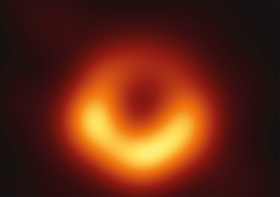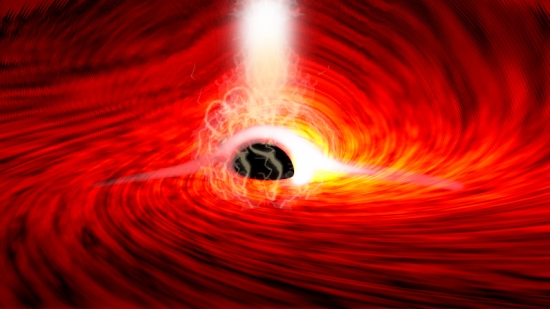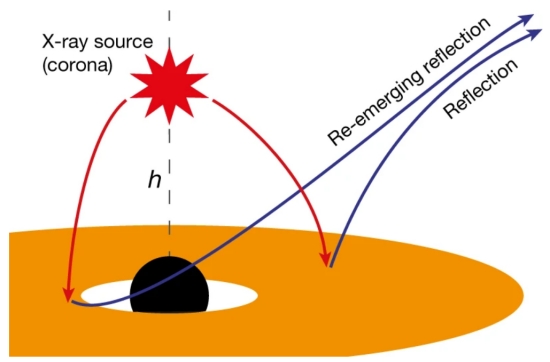The first direct observation of light from behind a black hole has just been described in a paper in Nature. What is striking in this work is not so much the confirmation, yet again, of Einstein’s General Relativity, but the fact that we can observe the effect in action in this environment. Having just read Heino Falcke’s Light in the Darkness: Black Holes, the Universe, and Us (HarperOne 2021), I have been thinking a lot about observing what was once thought unobservable, as Falcke and the worldwide interferometric effort called the Event Horizon Telescope managed to do when they produced the first image of a black hole.

The famous image out of that work that went worldwide in the media was of the supermassive black hole at the center of the galaxy M87, while the new paper — which offers no image but rather data on telltale X-ray emissions — covers a galaxy called I Zwicky 1 (I Zw 1), a Seyfert galaxy 800 million light years from the Sun. These are active galaxies with supermassive black holes at their centers and quasar-like nuclei. The data on this one were drawn from observations of I Zw 1 in early 2020 by the X-ray telescopes NuSTAR and XMM-Newton.
Image: The image of the black hole at the center of M87 shows the effect of the accretion disc as well as the black hole’s shadow. Credit: Akiyama et al. and ApJL.
Dan Wilkins, lead author of the paper on this work in Nature, is a research scientist at the Kavli Institute for Particle Astrophysics and Cosmology at Stanford and SLAC National Accelerator Laboratory. He explains how the malleability of spacetime makes the observations of I Zw 1’s black hole possible:
“Any light that goes into that black hole doesn’t come out, so we shouldn’t be able to see anything that’s behind the black hole. The reason we can see that is because that black hole is warping space, bending light and twisting magnetic fields around itself.”

Image: Researchers observed bright flares of X-ray emissions, produced as gas falls into a supermassive black hole. The flares echoed off of the gas falling into the black hole, and as the flares were subsiding, short flashes of X-rays were seen – corresponding to the reflection of the flares from the far side of the disk, bent around the black hole by its strong gravitational field. Credit: Dan Wilkins.
Material moving in the innermost regions of the accretion disk around a supermassive black hole forms a compact and variable corona of X-ray light near the object that allows scientists to map and characterize the accretion disk. Here superheated gas creates a magnetized plasma caught in the black hole’s spin. The magnetic field twists around itself, eventually breaking. The X-rays are reflected from the accretion disk, which gives us a look at events just outside the black hole’s event horizon.
All of this fits current thinking about how the black hole corona forms, but the researchers then detected a series of smaller X-ray flashes, reflections from the inner part of the accretion disk with calculable reverberation time delays. Wilkins calls these ‘echoes’ because they are the same X-ray flares but reflected from the back of the disk. In essence, this gives us the first information we have to characterize the far side of a black hole, and follows from Wilkins’ earlier research. The scientist adds:
“This magnetic field getting tied up and then snapping close to the black hole heats everything around it and produces these high energy electrons that then go on to produce the X-rays. I’ve been building theoretical predictions of how these echoes appear to us for a few years. I’d already seen them in the theory I’ve been developing, so once I saw them in the telescope observations, I could figure out the connection.”

Image: This is Figure 2 from the paper, labelled “Schematic of the X-ray reverberation model.” Caption: X-rays are emitted from a corona of energetic particles close to the black hole. Some of these rays reach the observer directly, but some illuminate the inner regions of the accretion disk and are observed reflected from the disk. Strong light bending in the gravitational field around the black hole focuses the rays towards the black hole and onto the inner regions of the disk. Rays reflected from the back of the disk can be bent around the (spinning) black hole, allowing the re-emergence of X-rays from parts of the disk that would classically be hidden behind the black hole. Credit: Wilkins et al.
What I find extraordinary is that we are getting a glimpse of the accretion disk at work to a fine level of detail. The flares in this black hole’s corona “reveal the temporal response of the illuminated accretion disk,” as the paper puts it, going on to explain the strong Doppler effects at play here:
Emission line photons from different parts of the disk experience different Doppler shifts, due to the variation in the line-of-sight velocity across the disk, and also experience gravitational redshifts, which increase closer to the black hole. The energy shifts of the line photons therefore contain information about the positions on the accretion disk from which they were emitted. The light travel time varies according to the distance of each part of the disk from the corona, and the line emission at different energy shifts is expected to respond to the flare at different times.
Data from the coronal flares and their reverberations allow the team to measure the height of the X-ray source above the disk and also to measure the mass of the black hole itself, which turns out to be on the order of 30 million solar masses. The authors go into detail about the factors at play in the mass estimate, and as the paper is available online, I’ll leave that analysis for those interested in following it up themselves.
Once again black holes provide a way of seeing what had been thought unobservable. Co-author Roger Blandford, also at Stanford, takes note of how far we’ve come:
“Fifty years ago, when astrophysicists started speculating about how the magnetic field might behave close to a black hole, they had no idea that one day we might have the techniques to observe this directly and see Einstein’s general theory of relativity in action.”
Pushing yet deeper will be the European Space Agency’s X-ray observatory Athena (Advanced Telescope for High-ENergy Astrophysics). Wilkins is part of the team developing the Wide Field Imager detector for the telescope, scheduled for launch in 2031.
The paper is Wilkins et al., “Light bending and X-ray echoes from behind a supermassive black hole,” Nature 595 (2021), 657-660 (abstract).



If Planet 9 does exist as a black hole…can it return a laser to give us a fix? A week or two ago at phys.org there was a paper with the term ‘rundt’ which means?
Awesome. Since x rays are high energy, they should also heat up the disk and there should be light in the infrared spectrum and also the visible spectrum. Shouldn’t we be able to know the chemical composition of the spectra of the emitted light o the accretion disk gases?
I realize I’m late to the party here and therefore unlikely to get my question answered. However, do black holes look the same from different directions? I’m sure we’re all familiar with the math based CGI picture of a black hole from the movie “Interstellar.” https://www.livescience.com/black-hole-mirror-copies.html. So my question is: Is this the view an observer sees the same regardless of direction? In other words, is the view the same if you’re “behind” the black hole, “above” the black hole, etc?
It’ll depend on a couple of things: spin and presence of an accretion disk. An isolated and non-rotating BH will look visually the same from all directions. However, by “look” we mean the circular void in the background since the BH is itself invisible.
Non-rotating BH don’t really exist. Spinning BH have an ergosphere that gives them an equatorial “bulge” that, while itself invisible (it’s just spacetime) can be observed by the effect on warping of light from behind it. That is, the shape and location of the Einstein rings.
When there is an accretion disk around a spinning BH it will tend to align itself to the spin equator due to frame dragging. Were there to exist a non-spinning BH, an accretion disk would have no preferred orientation, dependent only on its own net angular momentum.
I see your point. If the BH spins, the warping of light around the BH will look different depending on your point of view.